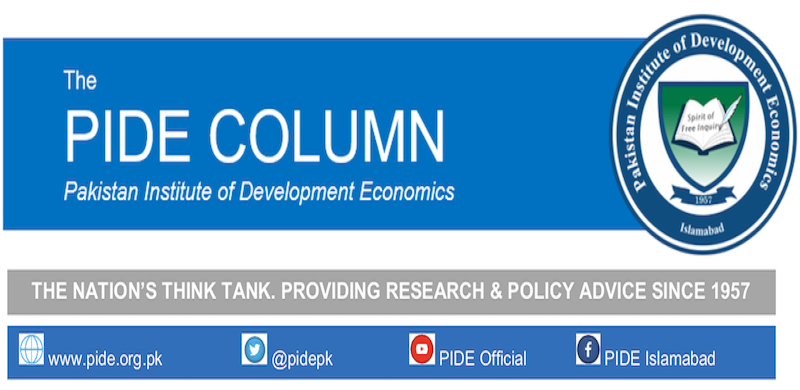
Energy Innovation is the application of various forms of innovative responses along the entire supply chain and demand. A recent webinarat PIDE on Energy Innovations, points out that the world’s commitments to SDG 7 has led to an increased share of renewables in the global energy mix and the new techniques have doubled energy efficiency.
Globally, micro-grids, micro-turbines, wind-turbines and solar photovoltaic are redefining energy generation and distribution. To reduce greenhouse gas emissions, to minimise costs and to improve resilience and dependability, the electricity systems through technological innovations are being decentralised, decarbonised and digitalised, referred to as “3 Ds”. Tailor-made renewable energy solutions provide an alternative to centralised grids, while battery storage provides 24/7 power supply despite intermittency of solar and wind. The emission-free system regulates and optimises power supply with a minimum human intervention using Artificial Intelligence (AI).
Since 2010, the Global investments in renewable energy exceed $2.6trillion. Global Trends in Renewable Energy Investment 2020 reports that the world renewable energy capacity in 2019, excluding hydro, grew by more than 184GW with an investment of $282.2 billion. In monetary terms this investment was only 1% higher than in 2018 due to fall in the cost of wind and solar energy. The fall in turn is owed to technological improvements, scale economies and greater competition. The developing countries, predominantly China and India are vigorously advancing on the innovation trek with $152 billioninvestment in 2019. In comparison, renewable capacity investment in Pakistan was only $0.6 billion.
With the circular debt of PKR 2.4 trillion, high system losses, huge capacity charges and dependence on imported fossil fuel, the energy cost is 26-28 pc higher than regional counterparts. Inadequate transmission and distribution infrastructure are adding fuel to the fire. Over 40 million people in Pakistan are not connected to the national grid, while 75 million grid-connected consumers face daily 12-hour rotational blackouts.
Energy innovations can help rein in rising electricity costs, decreases dependency on imports, reduces environmental degradation and supply clean energy to those who are under or un-served. Realising the potential of sustainable energy innovation in the supply chain requires tilling across generation, transmission, and energy distribution.
The wind power was launched in Pakistan nearly 15 years ago with a high dependency on imported services. Progress remained slow due to high prices. Potential for solar and wind power is quite high in the country. According to the World Bank, the exploitation of merely 0.071% of solar power potential would meet country’s current electricity demand. Solar and wind power which are now the cheapest sources of power generation are gaining a foothold in the country; but still with 95 pc reliance on foreign markets, mainly China, for the equipment required. The local industry suffers from pricing issues because of high taxes - availability of cheap imported solar appliances makes it harder to compete.
On the transmission side, globally deployed innovations of smart wires, metering infrastructure and digitalised appliances face availability restrictions in Pakistan. At the distribution end, electricity theft – one of the major reasons for circular debt – can be controlled by using smart technology however cost factor impedes its deployment.
In FY 2020, the installed capacity of solar and wind energy in Pakistan was 1678 MW, making it 4% of the total capacity and hardly 1% of the electricity generated. The Renewable Energy Policy 2020 has targeted to increase renewable energy to 30 pc by 2030. This would save up to $5 billion over the next 20 years.
Limited resources, over-regulated energy sector and lack of institutional infrastructure and capacity are hindering innovations in Pakistan. These are limiting the integration of renewables with conventional technologies. Elimination of taxes on manufacturing solar and wind energy equipment locally is planned. Phasing-out exemptions on imported renewable energy products is also planned to provide a level playing field to local and foreign suppliers. Several collaborations with international institutions are in the pipeline to pace up transition to renewable energy. Still, a lot more has to be done.
Apt policy interventions are critical for a resilient energy system. To have access to cheap energy, indigenous resources must be replaced with imported alternates. Meeting this challenge requires a radical change in the energy system, regulatory support and adopting alternative energy solutions through innovations. There is a need to empower people as effective participants in the decentralised energy system for the future.
The state of science and technology has been less satisfactory in Pakistan. There is a weak link between industry and academia/ research institutions and lack of funds for scientific research to develop alternative energy solutions. No research is of any use unless it is demand-driven and people-centric. The need is to bridge the gap between academia and industry through encouraging demand-driven research with state funding. It is the time to square our shoulders, make collective efforts and carefully tread the global trends of energy innovations.
